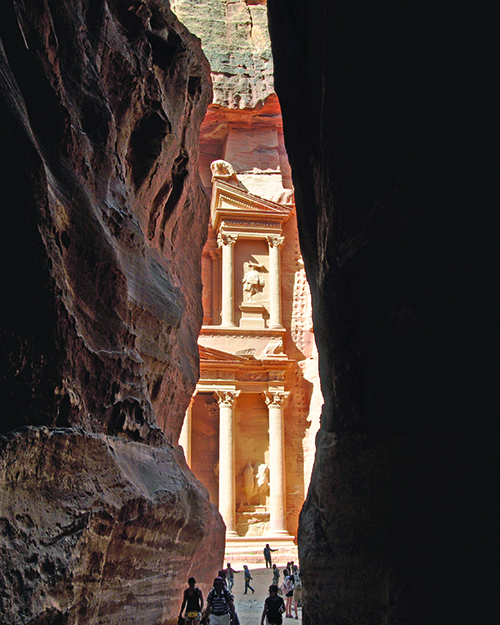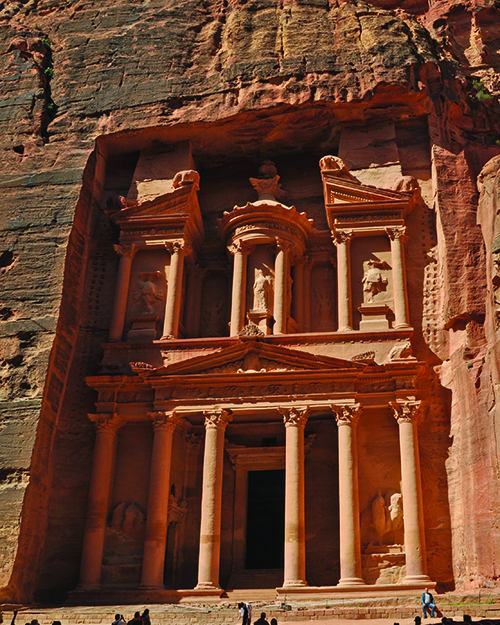

by Leon Mauldin
Synopsis: Located in the rugged desert canyons and mountainous region of southern Jordan, Petra was the capital of an ancient empire. Called the Rose City, Petra is famous for its tombs and temples that were carved into pink sandstone cliffs.
In Old Testament times, Petra was in the territory of Edom. During the Divided Kingdom period, Judah's King Amaziah (797-767 BC) captured Sela: "He struck down ten thousand Edomites in the Valley of Salt and took Sela by storm, and called it Joktheel, which is its name to this day" (2 Kings 14:7, ESV). Though not unanimous, many scholars identify Sela, which literally means, "The Rock," as the city of Petra.
It is possible that, when Paul went to Arabia following his conversion and early preaching in Damascus, he went to Petra. "In his Letter to the Galatians, Paul writes that, while he was at Damascus, he 'went away into Arabia' for a time (Gal. 1:17). He does not say exactly where, nor does he say why. 'Arabia' in Paul's time was the region of the Nabateans, whose capital was the isolated rock-carved city of Petra in the lonely wilderness of ancient Edom" (The Biblical World in Pictures). R.N. Longenecker writes, "It [Arabia] lay to the east of the Jordan valley rift, and traditionally extended from the Red Sea on the southwest to the Euphrates River on the northeast. Its main cultural centers were Petra in the south and Bostra in the north" (34).
The Lexham Bible Dictionary has this information on Petra:
Prior to occupying Petra, the Nabataeans were a nomadic people. They flourished in Petra during the late Hellenistic and early Roman periods. Before the arrival of the Nabataeans, the region had been part of Iron Age Edom, whose neighboring tribal kingdoms were Moab to the north and Ammon in the northeast (Barrett, The Ceramic Oil Lamp, 17).
Apart from archaeological excavations, which have offered insight into the ancient Nabataean kingdom, two classic sources have formed the basis of historical studies of the Nabataeans:
Petra became a Nabataean settlement in part because of the security provided by its towering cliffs and water. Due to Petra's location, the Nabataeans controlled one of the major lines of communication between the East and West, stimulating the cultural and commercial exchanges across the area. Until its eventual defeat by the Romans in the second-century AD, Petra served as one of the places in which both art and the Hellenistic civilization were preserved (Horsfield, "Sela-Petra [1960]," 1).
Consequently, the economic power exhibited by the state of Nabataea during the first centuries BC and AD was due to their control of the trade route between the Arabian coasts and the Far East. The commercial trade fostered diplomatic relations between Nabataean monarchs and the Hasmonaean and Herodian dynasties of Judaea, as well as with the Roman authorities. Much of the Nabataean chronology of rulers has been established with some certainty because of Nabataean Aramaic inscriptions and coinage (Barrett, The Ceramic Oil Lamp, 21).
The first Nabataean ruler named in ancient literature is Aretas I, who is also mentioned in 2 Maccabees 5:8. During the days of Aretas I (ca. 150 BC), Jason served as the high priest in Jerusalem. As Jason had become the high priest by means of a "present" to King Antiochus IV, he later was excluded from office and supplanted by Menelaus. Thus, Jason was forced to flee Jerusalem and requested asylum from Aretas I in 168 BC (Hammond, "New Light on the Nabataeans," 2). Most of the Nabataean rulers who reigned in Petra from Aretas I until the end of the Nabataean kingdom in AD 106 are well-known. The Syrian governor Cornelius Palma, a Roman general and legate of Trajan, annexed the Nabataean kingdom to Rome in AD 106. Although Petra was no longer the capital of the province, it flourished for a time under Roman rule. Petra's decline was accelerated by several earthquakes, and the city was eventually abandoned during the Arab conquest of the mid-seventh century (Báez, "Petra").
The Biblical World in Pictures. Washington D.C.: Biblical Archaeology Society 2003.
Longenecker, Richard N. Word Biblical Commentary: Galatians. Vol. 41. Dallas: Word, Incorporated, 1998.
Báez, Enrique. "Petra." The Lexham Bible Dictionary. J. D. Barry, Editor. Bellingham, WA: Lexham Press, 2016.
Author Bio: Leon has worked with the Hanceville church of Christ in Hanceville, AL for 29 years. He and his wife, Linda, have three children and eight grandchildren (one deceased). The church's website is hancevillechurchofchrist.com Leon's Message Board, devoted to Bible History and Geography, is bleon1.wordpress.com. To learn about his biblical tours, please visit mauldinbiblelandtours.com. He can be reached at leon.mauldin@gmail.com.

Image 1: The Siq, the entrance into Petra.

Image 2: The Royal Tombs, also known as The Treasury.